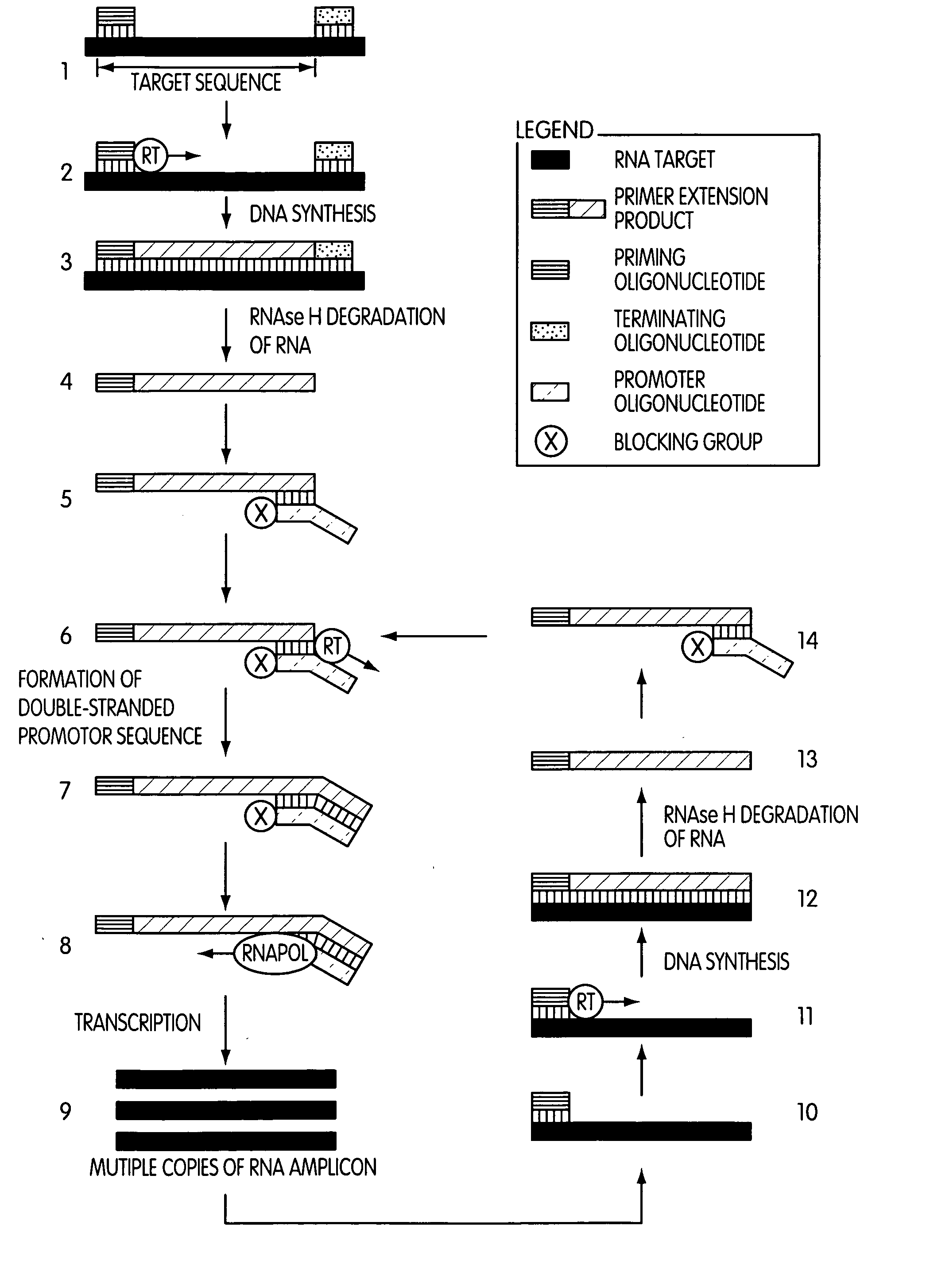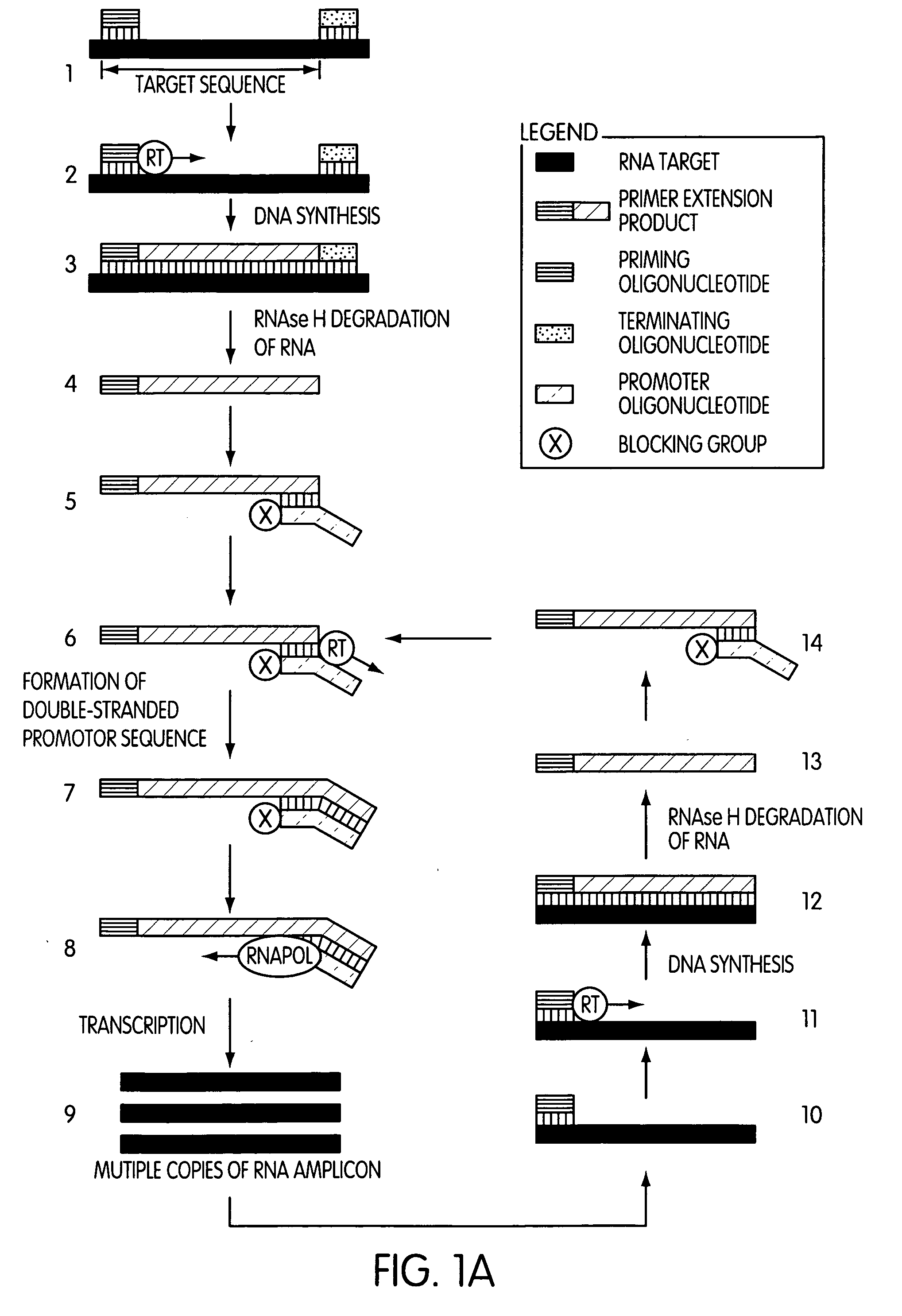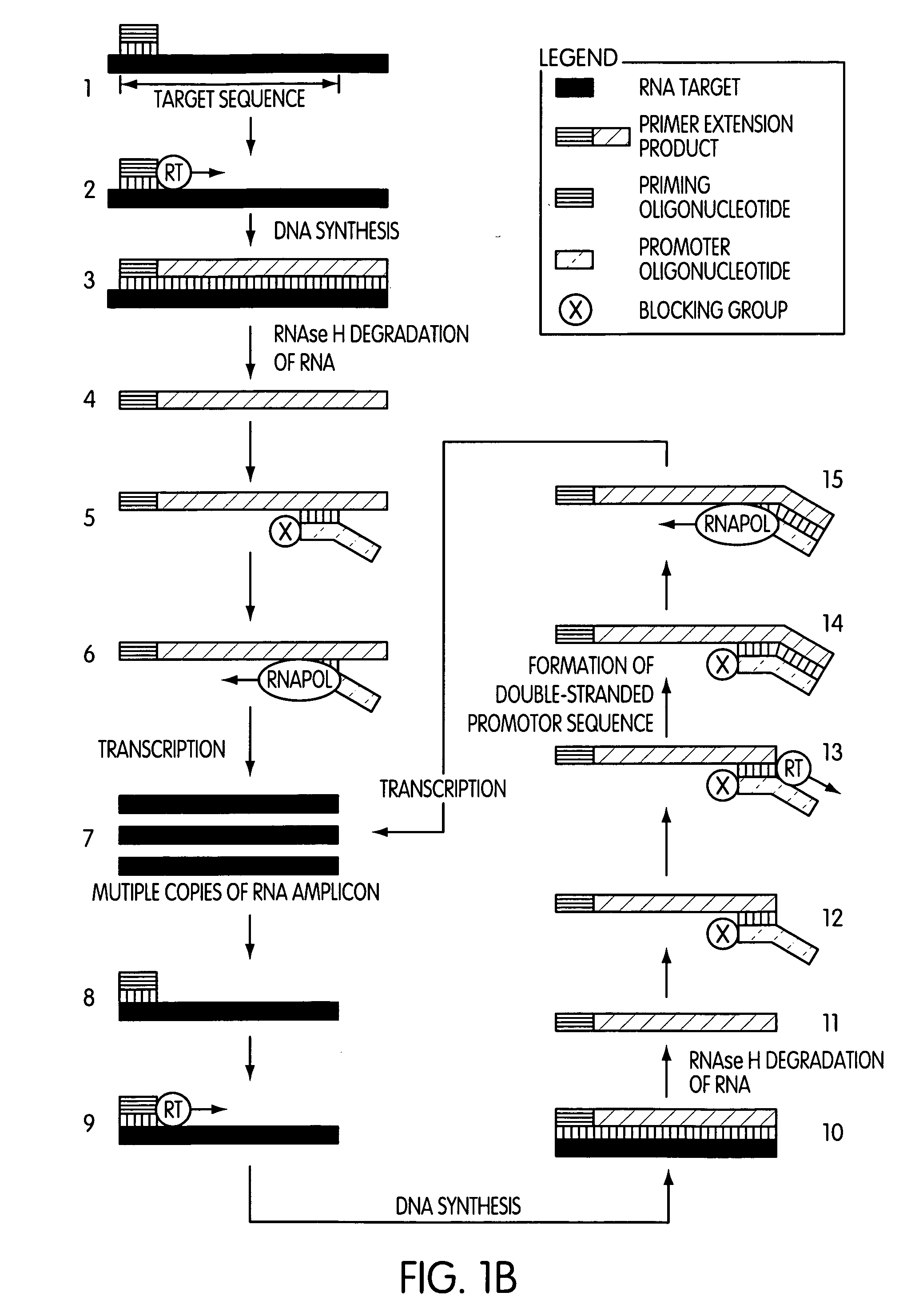[0009] The present invention is directed to novel methods of synthesizing multiple copies of a target sequence which are autocatalytic (i.e., able to cycle automatically without the need to modify
reaction conditions such as temperature, pH, or
ionic strength and using the product of one cycle in the next one). In particular, the present invention discloses a method of nucleic acid amplification which is robust and efficient, while reducing the appearance of side-products. The method uses only one primer, the “priming
oligonucleotide,” a
promoter oligonucleotide modified to prevent the
initiation of
DNA synthesis therefrom (e.g., includes a 3′-blocking
moiety) and, optionally, a binding molecule and / or a 3′-blocked
extender oligonucleotide, to amplify
RNA or
DNA molecules
in vitro. The methods of the present invention minimize or substantially eliminate the emergence of side-products, thus providing a high level of specificity. Furthermore, the appearance of side-products can complicate the analysis of the amplification reaction by various molecular detection techniques. The present invention minimizes or substantially eliminates this problem, thus providing an enhanced level of sensitivity.
[0010] In one embodiment, the present invention is drawn to a method of synthesizing multiple copies of a target sequence comprising treating a target nucleic acid which comprises an
RNA target sequence with a priming oligonucleotide and a binding molecule (e.g., terminating oligonucleotide or
digestion oligonucleotide), where the priming oligonucleotide hybridizes to the 3′-end of the target sequence such that a
primer extension reaction can be initiated therefrom, and where the binding molecule binds to the target nucleic acid adjacent to or near the 5′-end of the target sequence (by “adjacent to” is meant that the binding molecule binds to a base of the target nucleic acid next to the 5′-terminal base of the target sequence and fully 5′ to the target sequence); extending the priming oligonucleotide in a
primer extension reaction with
a DNA polymerase, e.g.,
reverse transcriptase, to give
a DNA primer extension product complementary to the target sequence, where the primer extension product has a 3′-end which is determined by the binding molecule, where the 3′-end of the primer extension product is complementary to the 5′-end of the target sequence; separating the primer extension product from the target sequence using an
enzyme which selectively degrades the target sequence, e.g., an
enzyme with an
RNAse H activity; treating the primer extension product with a
promoter oligonucleotide comprising first and second regions, where the first region hybridizes to a 3′-region of the primer extension product to form a promoter oligonucleotide:primer extension product
hybrid, where the second region comprises a promoter for an
RNA polymerase and is situated 5′ to the first region, and where the promoter oligonucleotide is modified to prevent the
initiation of
DNA synthesis therefrom (e.g., a blocking
moiety is situated at the 3′-terminus of the promoter oligonucleotide which prevents
polymerase extension); extending the 3′-end of the primer extension product in the promoter oligonucleotide:primer extension product
hybrid to add a sequence complementary to the second region of the promoter oligonucleotide; and transcribing from the promoter oligonucleotide:primer extension product
hybrid multiple RNA products complementary to the primer extension product using an
RNA polymerase which recognizes the promoter in the promoter oligonucleotide and initiates transcription therefrom. According to this embodiment, the base sequences of the resulting RNA products are substantially identical to the
base sequence of the target sequence. In a preferred method according to this embodiment, the activity of the
DNA polymerase is substantially limited to the formation of primer extension products comprising the priming oligonucleotide. In yet another preferred method according to this embodiment, the formation of side-products in the method is substantially less than if said promoter oligonucleotide was not modified to prevent the
initiation of
DNA synthesis therefrom. According to yet another preferred method of this embodiment, if an oligonucleotide used in the amplification reaction comprises a promoter for an
RNA polymerase, then that oligonucleotide further comprises a blocking
moiety situated at its 3′-terminus to prevent the initiation of
DNA synthesis therefrom.
[0011] A second embodiment of the present invention is drawn to a method of synthesizing multiple copies of a target sequence, where the method comprises treating a target nucleic acid comprising an RNA target sequence with a priming oligonucleotide which hybridizes to the 3′-end of the target sequence such that a primer extension reaction can be initiated therefrom; extending the priming oligonucleotide in a primer extension reaction with
a DNA polymerase, e.g.,
reverse transcriptase, to give a first DNA primer extension product having an indeterminate 3′-end and comprising a base region complementary to the target sequence; separating the first primer extension product from the target nucleic acid using an
enzyme which selectively degrades that portion of the target nucleic acid which is complementary to the first primer extension reaction, e.g., an enzyme with an
RNAse H activity; treating the first primer extension product with a promoter oligonucleotide comprising first and second regions, where the first region hybridizes to a 3′-region of the first primer extension product to form a promoter oligonucleotide:first primer extension product hybrid, where the second region comprises a promoter for an RNA polymerase and is situated 5′ to the first region, and where the promoter oligonucleotide is modified to prevent the initiation of DNA synthesis therefrom (e.g., a blocking moiety is situated at the 3′-terminus of the promoter oligonucleotide which prevents polymerase extension); and transcribing from the promoter oligonucleotide:first primer extension product hybrid multiple first RNA products complementary to at least a portion of the first primer extension product using an RNA polymerase which recognizes the promoter and initiates transcription therefrom, where the base sequences of the resulting first RNA products are substantially identical to the
base sequence of the target sequence. In a preferred method according to this embodiment, the activity of the
DNA polymerase in the method is substantially limited to the formation of primer extension products comprising the priming oligonucleotide. In yet another preferred method of this embodiment, the formation of side-products in the method is substantially less than if the promoter oligonucleotide was not modified to prevent the initiation of DNA synthesis therefrom. According to yet another preferred method of this embodiment, if an oligonucleotide used in the amplification reaction comprises a promoter for an RNA polymerase, then that oligonucleotide further comprises a blocking moiety situated at its 3′-terminus to prevent the initiation of DNA synthesis therefrom.
[0024] Certain embodiments of the present invention include one or more detection probes for determining the presence or amount of the RNA and / or DNA products in the amplification reaction mixture. Probes may be designed to detect RNA and / or DNA products after the amplification reaction (i.e., end-point detection) or, alternatively, during the amplification reaction (i.e., real-time detection). Thus, the probes may be provided to the reaction mixture prior to, during or at the completion of the amplification reaction. For real-time detection of RNA products in the first two methods described above, it may be desirable to provide the probe to the reaction mixture after the first primer extension reaction has been initiated (i.e., addition of amplification enzymes) since probe binding to the target sequence, rather than RNA product, may slow the rate at which an RNA-dependent
DNA polymerase (e.g.,
reverse transcriptase) can extend the priming oligonucleotide. Preferred probes have one or more associated labels to facilitate detection.
 Login to View More
Login to View More 


